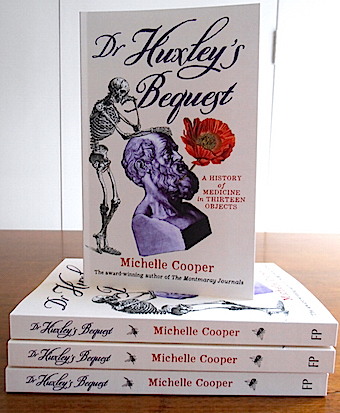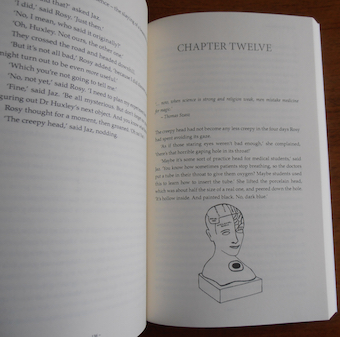I’m very happy to be back at Kingscote with the Marlow twins, a year after their eventful Autumn Term, because I have plenty of questions I need answered. Did Nicola get promoted to Form IIIA, leaving Lawrie and Tim behind? Will Nicola get a chance to triumph on the netball courts this year? Will she ever find a worthy Best Friend? How will Ann cope with being Eldest Remaining Marlow Sister? And who will be Head Girl now Karen and Rowan have departed? (Surely not Lois Sanger. But the teachers seem clueless as to Lois’s true character, so it’s possible.)
 It seems that Christmas is a good time to begin reading End of Term, because the plot seems to feature a Nativity Play. That’s pretty much all I know about this book. The cover is not very informative or even very accurate – if that’s the twins with their new short hairdos in front, why are they wearing scarlet uniforms? Unless Nicola used her Boke of Falconerie windfall to buy uniforms, which seems pretty unlikely…
It seems that Christmas is a good time to begin reading End of Term, because the plot seems to feature a Nativity Play. That’s pretty much all I know about this book. The cover is not very informative or even very accurate – if that’s the twins with their new short hairdos in front, why are they wearing scarlet uniforms? Unless Nicola used her Boke of Falconerie windfall to buy uniforms, which seems pretty unlikely…
Chapter 1: Sprog Takes a Quarry
So, we begin at Colebridge Junction where Ann, Ginty, Nicola and The Sprog are waiting resignedly for their train to school and Lawrie is acting like a fractious five-year-old. Kingscote is a mere forty minutes by road from Trennels, but do the Marlow parents do the sensible thing and drive the girls and their luggage to school? No, they make them take a three-hour train trip, so the sisters can bond with their fellow pupils on the journey and Nicola can do something dramatic and dangerous to start the book off with a bang. (By the way, I always wondered about the Hogwarts school train. Did Scottish students need to travel all the way to London to catch the train all the way back to Scotland? If they could Floo or Side-Along Apparate with their parents to London to catch the train, why couldn’t they just travel directly to Hogsmeade, then get on the boats or carriages to Hogwarts?)
Anyway, after helping Ginty avoid Unity Logan and watching Lawrie boasting about her new theatrical mentor to Tim and company, Nicola sensibly decides to take The Sprog to the relative peace and quiet of the guard’s van. Everything is going swimmingly until they stop at the penultimate train station and The Sprog flies out the open door after some birds and Nicola tears off after him. Well, at least this time the train was actually stopped of its own accord at a station when she leapt out. And she does catch up with The Sprog, and even better, he’s caught his first sparrow (probably accidentally, but they’re both very proud of him). They trek back to the station, to find the next train isn’t due for three hours and worse, a new girl called Esther Frewen, who snubbed Nicola’s welcoming gestures on the train, is there too, after trying to run away back home.
Nicola really is a very kind and sympathetic child, even if she doesn’t always understand others’ insecurities and anxieties, being a very secure and fearless person herself. She realises they can walk to school across the fields and she tactfully talks about Sprog and school and the famous Marlow family until Esther gets her tears under control. Poor Esther is the only child of divorced parents, which must have been pretty unusual in 1950s England, although Nicola thinks “there were quite a few people at Kingscote to whom this beastly thing had happened”. Even worse, Esther’s had to leave her young puppy, Daks, at home because new girls aren’t allowed to bring pets (yet another of Kingscote’s arbitrary and illogical rules, I suppose, although I do wonder why Esther got a new puppy just when she was about to leave for boarding school).
Back at school, poor Ann is in a flap about Nicola going missing (“You wouldn’t have done this to Rowan”) and has already unpacked Nicola’s things into her drawer completely the wrong way:
“What with depressed new girls and pained sisters and misarranged drawers, Nicola saw no hope for the term at all.”
Such trials and tribulations! So Nicola stomps off to see to Sprog.
Chapter 2: Friends and Enemies
Ugh, Miss Redmond! She corners Lawrie and Nicola on their very first day back and graciously condescends to permit them to rejoin the Guides, saying “everyone was most anxious to be able to feel they could forget the whole unfortunate affair and begin again with an entirely clean sheet”. Oh, and Lois Sanger “was very keen to have them back with the Scarlet Pimpernels”! Lawrie, as usual, goes “scarlet and dumb” and expects Nicola to respond: Nicola quite rightly tells Miss Redmond to go jump in the lake. Miss Redmond storms off in an outraged huff and Tim appears, enjoying the strife. It seems Tim and Lawrie are now Best Friends Forever and both of them quite like Lois after she helped them with their play, but Nicola does not forgive and forget so easily.
Fortunately, Nicola seems to have found a new friend in Miranda West:
“Their hands banged together, and clasped and swung energetically as they went along the path to the outhouse. It was odd how people changed – or else you did – Nicola wasn’t sure which. A year ago, Miranda West had been one of III A’s form prefects, a bossy, conceited person, who made no bones about despising the worms of Third Remove. Then first [Nicola], and later Lawrie and Tim, had moved into III A themselves … and suddenly, last summer term, she had become someone to grin at across the classroom – someone who saw the same joke at the same time as you did.”
Miranda is described as having a “vivid, clever little Jewish face” and having “extremely rich” parents. She does seem to share Tim’s disregard for school rules, but has slightly more School Spirit and is worried that now Rowan has left, they might end up with Lois Sanger as Games Captain (Miranda accurately describes Lois as “slippery soap and slithery slime”). And worse luck, Lois has been made Games Captain, as well as being a prefect! Lois is busy crowing to her friends about how Rowan hasn’t even been made a prefect, when Nicola storms up to inform her that Rowan has left school. Take that, Lois! Nicola storms off, leaving Lois’s friends moaning about kids these days, no manners, etc. There’s a lot of storming off in this chapter.
Someone useless called Val Longstreet is Head Girl (to replace useless Karen) and someone called Janice Scott is a prefect, although Miranda wishes Janice had been made both Head Girl and Games Captain. Miranda has a bit of a crush on Janice, but denies it (“I mean, I like looking at her, quite, but not if you mean giving her roses in silver paper, and sleeping with her kirbigrips under my pillow”). Apparently the kirbigrips thing really happened a few years back, with some Lower Fifths obsessing over a couple of older girls, until Miss Keith called a special school assembly to shame the younger girls in the most public and humiliating way possible. (Because she couldn’t possibly have had a quiet sensible word with them right at the start about respecting other people’s privacy, before they got obsessive, and given them a copy of The Friendly Young Ladies.)
Then Nicola and Miranda meet up with Tim and Lawrie. Tim distributes chocolates and Lawrie complains about “the beastliest First Day I’ve ever met”. It turns out the cast list for the Christmas Play has been posted on the noticeboard, and casting depends on good character, not acting or singing talent. Accordingly, Lawrie and Tim are only Crowd. Nicola, who has a much better character, is a Candle Angel. A nice but useless girl called Jess Geddes is Shepherd Boy, the role that Lawrie covets. Ann is Mary, which makes sense, Val is Joseph because she’s Head Girl, and slimy Lois is Reader Angel (although at least Lois has proven reading-aloud skills). Miranda isn’t in it at all, presumably because she’s Jewish (she refers to it as “your play”). I can’t see why she can’t join in, though. She wants to be in it and it’s only a school play. If it’s like most of the Nativity Plays I’ve seen, with singing sheep and so on, it won’t even be particularly Biblical (not that the Gospels tell a consistent story about the birth of Jesus anyway) and it’s being held in a school theatre, not a church. Anyway, I’m sure there’ll be major drama involving the casting before too long.
Next, Chapter Three: Rehearsals and Team Practices
You might also be interested in reading:
‘End of Term, Part Two
‘End of Term’, Part Three
‘End of Term’, Part Four
‘End of Term’, Part Five
‘End of Term’, Part Six
‘End of Term’, Part Seven
‘Autumn Term’ by Antonia Forest
‘The Marlows and the Traitor’ by Antonia Forest
‘Falconer’s Lure’ by Antonia Forest






